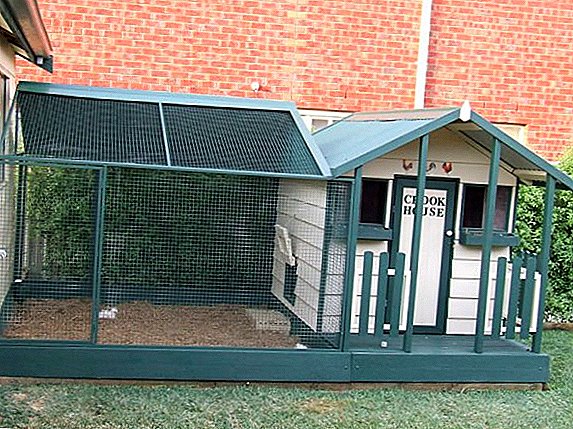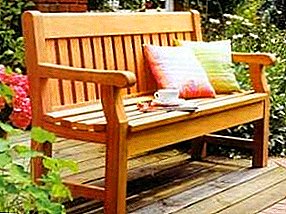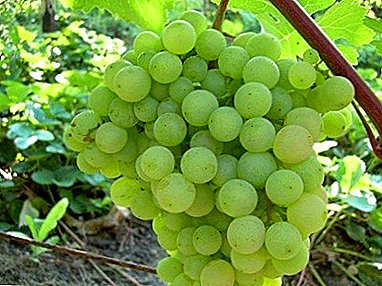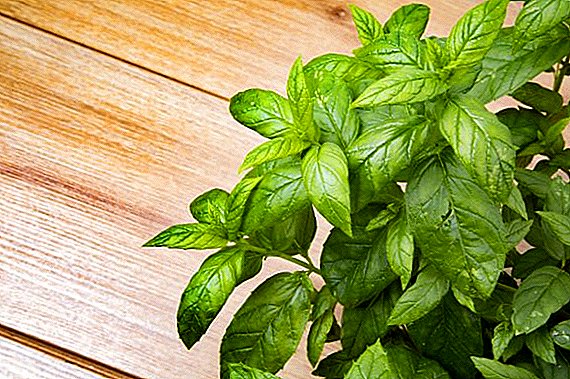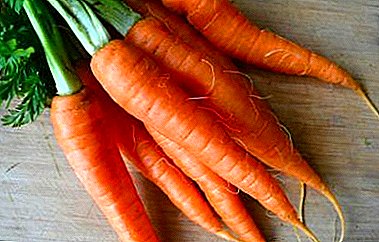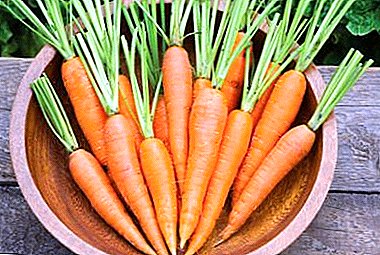
Carrots - is one of the most popular vegetables, which has a universal purpose. You can use it in fresh and canned form, as well as stored throughout the spring.
Most often, root vegetables are stored in the cellar, but not all houses provide for them.
This is not a reason to abandon the harvest, as you can save its appearance and taste with the help of other equally effective ways.
Features of the product structure
Carrots are a two-year culture, which has developed the ability to be at a low temperature in a state of shallow dormancy. When creating full-fledged conditions, its growth is restored again. The state of forced rest is required by the plant in order to complete all the generative processes of development.
 With the onset of autumn, their growth at high temperature takes on a vegetative character. In the spring, after a certain period of time, sprouts are formed. These are the beginnings of future generative shoots.
With the onset of autumn, their growth at high temperature takes on a vegetative character. In the spring, after a certain period of time, sprouts are formed. These are the beginnings of future generative shoots.
In the case of fruits that have not ripened, the processes of budding the buds of the inflorescences have not been completed for a long time, therefore they are distinguished by high longevity.
The degree of maturation of carrots can be understood by the ratio of sucrose to monosaccharides. If it is higher than 1, then the maturation is excellent and the incidence is high, and if it is below 1, then the maturation is poor and the incidence is low.
What sort can be stored for the winter?
Prolonged storage of the crop in the winter in an apartment without a cellar depends on the choice of variety.
For long-term storage you need to choose late-ripening varieties., the length of root crops is not less than 20 cm. For this purpose, these types of carrots are perfect:
- Forto.
- Valeria.
- Vita Long
- Moscow winter.
- Berlicum
- Nuance.
- Queen of autumn.
- Karlen.
- Flaccore.
- Samson.
- Shantane.
They have a much longer shelf life than others.
Effective ways
So how best to store carrots? Root crops are stored in the cellar using several methods:
 Plastic bags.
Plastic bags.This method is one of the most common. Pour 5-6 kg of prepared root crops into the bag, tie and put upright. If condensation occurs, then a small hole should be made on the walls to evaporate it.
You can pack 20 kg of vegetables in a bag, but then you can put wet sawdust on top, a layer of which is 10 cm.
The main advantage of the method is that the bag forms high humidity and the necessary amount of carbon dioxide. This has a positive effect on the quality preservation of carrots.
- On top of potatoes.
In a cellar on potato claps, carrots should be laid in layers, the thickness of which is 2-3 cm. Thus, root crops absorb excess moisture.
- Claying.
The essence of this method is to dip the roots in a clay mash and place them in boxes that have gaps for ventilation.
To make a talker, you need to combine the clay with water to obtain a creamy consistency. A layer of clay will gradually dry on vegetables and protect them from withering, moisture evaporation and various diseases. Before eating carrots, clay is very easily washed off with plain water.
- In sand.
Put sand on the basement floor. The thickness of the layer should be 5 cm. Lay carrots on it in rows so that the roots are directed inwards. In this case, the roots should not be in contact with each other. Cover the vegetables with sand 1-2 cm and lay a new row of the crop. Similarly, perform a stack of up to 1 m.
If the basement is dry, the sand should be wet. And if the room is wet, the sand is dry.
- In sawdust.
Coniferous sawdust is used to store carrots. This method allows you to protect vegetables from germination and white rot. The fact is that sawdust contains essential oil, which has a disinfecting effect.
Sawdust should be wet 18-20%. For 200 kg of crop, 0.1 m3 of sawdust is required.
Ordinary canvas bags and moss can also be used for storage.
Can I leave vegetables outside the basement?
Sure you may. There are certain methods for storing crops without the use of a cellar. If you exactly meet all the conditions, then the collected roots will lie no worse than in the basement, preserving their taste and appearance. Outside the basement, for example, dried carrots are well preserved.
What if there is no pit?
If there is no cellar and a storage pit, you can use the following methods:
On the balcony
To store carrots on the balcony you need to prepare a plastic box, sawdust or sand. With this storage method it is important that the temperature is not above 0 degrees, and sunlight does not penetrate the rootsotherwise their quality will go down. Carrots change color, begin to turn green, and its taste gets a bitter taste.
 Before laying the roots cleaned from the ground, washed and dried.
Before laying the roots cleaned from the ground, washed and dried.- Then pour sand on the bottom of the box, layer thickness is 2 cm. Lay the roots in rows and fill up with sand again.
- Similarly, spread the roots until they fill the entire height of the box.
- Set the capacity on the balcony or glazed loggia.
In a refrigerator
- If the method of storage in the refrigerator is chosen, then the crop should be washed and dried for 2-3 hours.
- Cut the tops, take a plastic wrap and 3-4 vegetables tightly wrap in 2-3 layers, and then another 2 more dense layers of the film.
- In small batches to put the carrots in the refrigerator in the box for storing vegetables.
- After this, make sure that it does not freeze.
Instead of plastic film fit plastic bags, you can use cans and other containers. For storage in the freezer is suitable mashed carrots or grated version of it.
Preservation
This method is great for those who live in a city apartment and they do not have the ability to store the harvest in the basement or pit. This will require carrots, brine (30 grams of salt per 1 liter of water).
- Wash and clean the roots.
- Dip them in boiling water for 2-3 minutes.
- For brine, pour salt, bring to a boil, pour vegetables with hot brine.
- Place the jars in a salt water sterilization container. Sterilize 1 liter capacity for 40 minutes.
Nuances and recommendations
If the cellar is missing, the ground will be an excellent storage option. This will save the roots until mid-spring without a cellar.
Procedure:
- During harvest leave the roots in the ground. Cut the tops completely.
- Cover the soil with foil, and cover it with filings and dry leaves.
- Lay the roofing material or polyethylene, fasten along the edges with heavy stones.
Vegetables will be well spent in the garden, but in early spring they will have to be dug out.
Fundamental rules
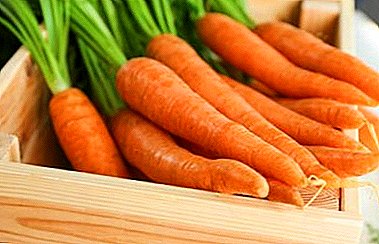 When storing vegetables at home, if there is no cellar, a number of important conditions must be met.:
When storing vegetables at home, if there is no cellar, a number of important conditions must be met.:
- Humidity should be in the range of 90-95%.
- Temperature indicators are not higher than +10 degrees. Otherwise, the carrot will begin to germinate and release moisture.
Additional tips and warnings
So, how to store beets and other vegetables without a cellar or basement? In order for the harvest to be kept for a long time and not to lose its qualities, it is necessary to adhere to the following recommendations.:
- The temperature should be stable, without sudden changes.
- Disinfect the room. For these purposes, the wall and floor to handle copper sulphate or lime.
- From time to time to inspect the crop, especially if the vegetables are in contact with each other.
- If carrots are stored in the refrigerator, it is best to use plastic bags. They perfectly retain moisture and do not allow the roots to dry.
Without packaging, harvest is prohibited. Because of the increased air circulation, the roots quickly begin to dry.
Using the presented methods of storing carrots, it is not necessary to have a basement. Observing all the conditions, having properly carried out the preliminary preparation of vegetables, you can keep them until next spring, and they will not lose their properties. All methods are simple, so that absolutely every farmer can do it.


 Plastic bags.
Plastic bags. Before laying the roots cleaned from the ground, washed and dried.
Before laying the roots cleaned from the ground, washed and dried.